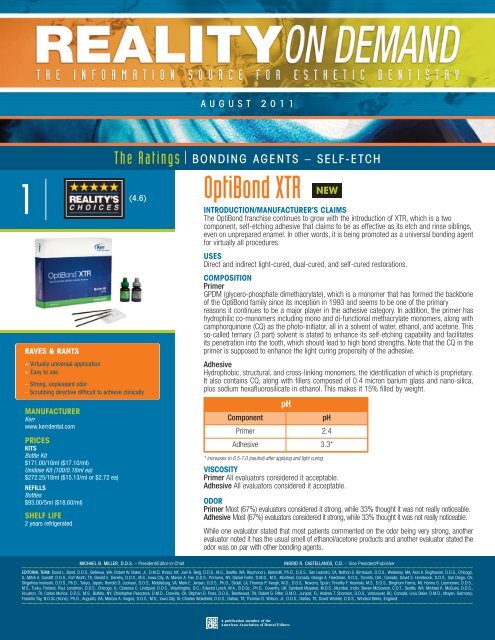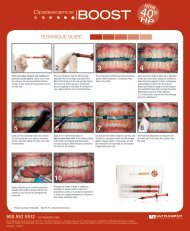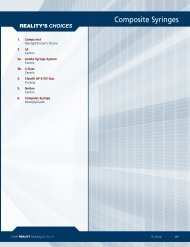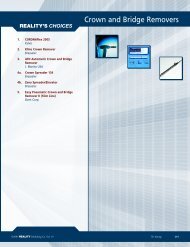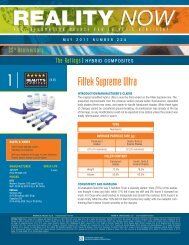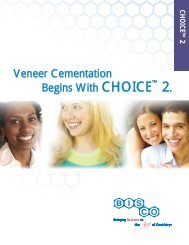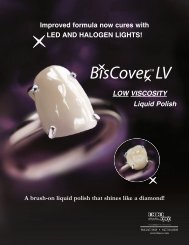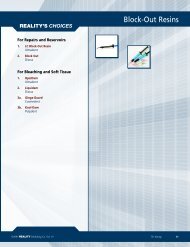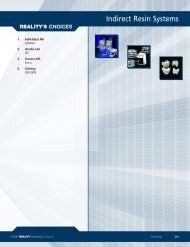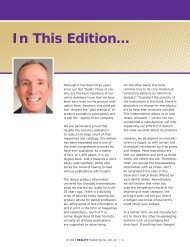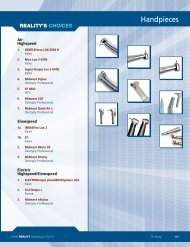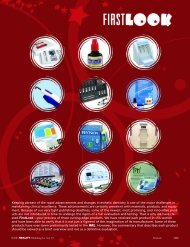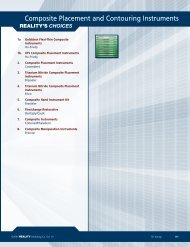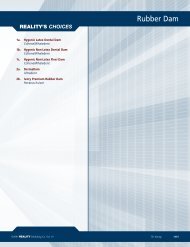OptiBond XTR - REALITY Publishing Company
OptiBond XTR - REALITY Publishing Company
OptiBond XTR - REALITY Publishing Company
Create successful ePaper yourself
Turn your PDF publications into a flip-book with our unique Google optimized e-Paper software.
25 th Anniversary<br />
1<br />
RAVES & RANTS<br />
A U G U S T 2 0 1 1<br />
The Ratings BONDING AGENTS – SELF-ETCH<br />
(4.6)<br />
+ Virtually universal application<br />
+ Easy to use<br />
– Strong, unpleasant odor<br />
– Scrubbing directive difficult to achieve clinically<br />
MANUFACTURER<br />
Kerr<br />
www.kerrdental.com<br />
PRICES<br />
KITS<br />
Bottle Kit<br />
$171.00/10ml ($17.10/ml)<br />
Unidose Kit (100/0.18ml ea)<br />
$272.25/18ml ($15.13/ml or $2.72 ea)<br />
REFILLS<br />
Bottles<br />
$93.00/5ml ($18.60/ml)<br />
SHELF LIFE<br />
2 years refrigerated<br />
<strong>OptiBond</strong> <strong>XTR</strong><br />
INTRODUCTION/MANUFACTURER’S CLAIMS<br />
The <strong>OptiBond</strong> franchise continues to grow with the introduction of <strong>XTR</strong>, which is a two<br />
component, self-etching adhesive that claims to be as effective as its etch and rinse siblings,<br />
even on unprepared enamel. In other words, it is being promoted as a universal bonding agent<br />
for virtually all procedures.<br />
USES<br />
Direct and indirect light-cured, dual-cured, and self-cured restorations.<br />
COMPOSITION<br />
Primer<br />
GPDM (glycero-phosphate dimethacrylate), which is a monomer that has formed the backbone<br />
of the <strong>OptiBond</strong> family since its inception in 1993 and seems to be one of the primary<br />
reasons it continues to be a major player in the adhesive category. In addition, the primer has<br />
hydrophilic co-monomers including mono and di-functional methacrylate monomers, along with<br />
camphorquinone (CQ) as the photo-initiator, all in a solvent of water, ethanol, and acetone. This<br />
so-called ternary (3 part) solvent is stated to enhance its self-etching capability and facilitates<br />
its penetration into the tooth, which should lead to high bond strengths. Note that the CQ in the<br />
primer is supposed to enhance the light curing propensity of the adhesive.<br />
Adhesive<br />
Hydrophobic, structural, and cross-linking monomers, the identification of which is proprietary.<br />
It also contains CQ, along with fillers composed of 0.4 micron barium glass and nano-silica,<br />
plus sodium hexafluorosilicate in ethanol. This makes it 15% filled by weight.<br />
pH<br />
NEW<br />
Component pH<br />
Primer 2.4<br />
Adhesive 3.3*<br />
* increases to 6.5-7.0 (neutral) after applying and light curing<br />
VISCOSITY<br />
Primer All evaluators considered it acceptable.<br />
Adhesive All evaluators considered it acceptable.<br />
ODOR<br />
Primer Most (67%) evaluators considered it strong, while 33% thought it was not really noticeable.<br />
Adhesive Most (67%) evaluators considered it strong, while 33% thought it was not really noticeable.<br />
While one evaluator stated that most patients commented on the odor being very strong, another<br />
evaluator noted it has the usual smell of ethanol/acetone products and another evaluator stated the<br />
odor was on par with other bonding agents.<br />
MICHAEL B. MILLER, D.D.S. – President/Editor-in-Chief INGRID R. CASTELLANOS, C.D. – Vice President/Publisher<br />
EDITORIAL TEAM: David L. Baird, D.D.S., Bellevue, WA; Robert W. Baker, Jr., D.M.D, Ithaca, NY; Joel H. Berg, D.D.S., M.S., Seattle, WA; Raymond L. Bertolotti, Ph.D., D.D.S., San Leandro, CA; Nathan S. Birnbaum, D.D.S., Wellesley, MA; Alan A. Boghosian, D.D.S., Chicago,<br />
IL; Mitch A. Conditt, D.D.S., Fort Worth, TX; Gerald E. Denehy, D.D.S., M.S., Iowa City, IA; Marvin A. Fier, D.D.S., Pomona, NY; Daniel Fortin, D.M.D., M.S., Montreal, Canada; George A. Freedman, D.D.S., Toronto, Ont., Canada; David S. Hornbrook, D.D.S., San Diego, CA;<br />
Shigehisa Inokoshi, D.D.S., Ph.D., Tokyo, Japan; Ronald D. Jackson, D.D.S., Middleburg, VA; Mark E. Jensen, D.D.S., Ph.D., Slidell, LA; Thomas P. Keogh, M.D., D.D.S., Navarra, Spain; Timothy F. Kosinski, M.S., D.D.S., Bingham Farms, MI; Hannu O. Laamanen, D.D.S.,<br />
M.S., Turku, Finland; Paul Landman, D.D.S., Chicago, IL; Clarence C. Lindquist, D.D.S., Washington, D.C.; Edward Lynch, M.A., B.D.Sc., Ph.D., Coventry, UK; Sandesh Mayekar, M.D.S., Mumbai, India; Steven McGowan, C.D.T., Seattle, WA; Michael K. McGuire, D.D.S.,<br />
Houston, TX; Carlos Muñoz, D.D.S., M.S., Buffalo, NY; Christopher Pescatore, D.M.D., Danville, CA; Stephen D. Poss, D.D.S., Brentwood, TN; Robert G. Ritter, D.M.D., Juniper, FL; Andrew T. Shannon, D.D.S., Vancouver, BC, Canada; Liviu Steier, D.M.D., Mayen, Germany;<br />
Franklin Tay, B.D.Sc.(Hons), Ph.D., Augusta, GA; Marcos A. Vargas, D.D.S., M.S., Iowa City, IA; Charles Wakefield, D.D.S., Dallas, TX; Thomas G. Wilson, Jr., D.D.S., Dallas, TX; David Winkler, D.D.S., Windsor Berks, England.<br />
A publication member of the<br />
American Association of Dental Editors<br />
1
WHAT IS THE MOST EFFECTIVE APPLICATION TECHNIQUE<br />
FOR ALL RESTORATIONS?<br />
1. Leave preparation DRY, but not desiccated. Most (78%) evaluators used<br />
dry, while the remaining 22% stayed with moist.<br />
2. Apply the Primer for 20s using SCRUBBING technique. Note that “scrubbing”<br />
is a relative term, since the applicator included in the kit is quite flexible<br />
and only permits a moderate amount of pressure during this scrubbing phase.<br />
Most (78%) evaluators used 20s, while 11% thought 10s was enough and<br />
11% felt 30s provided a higher confidence level. The scrubbing technique,<br />
however, was a tougher sell, with less than half (44%) of the evaluators using<br />
it compared to 56% using gentle agitation. We continue to recommend scrubbing,<br />
but we acknowledge that it is not always easy to perform intraorally,<br />
especially with the supplied applicator tips.<br />
3. Apply GENTLE AIR initially followed by MEDIUM AIR to evaporate the solvents.<br />
Most (56%) evaluators used medium air, while 44% used gentle air,<br />
with at least two evaluators finishing with medium air.<br />
4. Apply Adhesive for 15s using GENTLE AGITIATION, followed by gentle to<br />
medium air to thin the layer and evaporate the solvent. If you are applying it<br />
for an indirect restoration, your air pressure needs to be strong enough to prevent<br />
the adhesive from pooling. If the adhesive layer pools or you have wrinkles,<br />
it could prevent complete seating of your restoration.<br />
5. Light-cure for 10s.<br />
Using this technique, the bond strengths (MPa) with light-cured composite<br />
were:<br />
SUBSTRATE IMMEDIATE 24 HOURS<br />
Enamel (unprepared) 19.2 33.13 Enamel (prepared) 17.41 28.24 Dentin 23.62 34.15 Interestingly, the bond strength to unprepared enamel actually appears to be<br />
higher than to prepared enamel. However, when the enamel fractures are<br />
taken into consideration (bond strength exceeded the cohesive strength of the<br />
substrate), there was very little difference between them. And, at 24 hours, all<br />
three substrates produced impressive results.<br />
With self-cured composite, bond strengths in MPa to dentin were:<br />
TIME BOND STRENGTH (MPA)<br />
5 min 11.7<br />
24 hrs 22.4<br />
2<br />
1 Enamel fractured in two specimens<br />
2 Dentin fractured in two specimens<br />
3 Enamel fractured in four specimens<br />
<strong>REALITY</strong><br />
OPTIBOND <strong>XTR</strong><br />
4 Enamel fractured in three specimens<br />
5 Dentin fractured in six specimens<br />
Strengths Can handle virtually all adhesive tasks. Easy<br />
to use with really good directions. Only two components.<br />
Most evaluators reported no sensitivity. No dislodgements<br />
reported during evaluation period. Thin film thickness<br />
facilitates complete seating of indirect restorations.<br />
Two dispensing options.<br />
INSIDE SURFACE OF INDIRECT RESTORATION<br />
Adhesive, but do not cure. If you are using a low viscosity resin cement, applying<br />
the Adhesive as a wetting agent may not be necessary.<br />
POST-OPERATIVE SENSITIVITY<br />
Most (78%) evaluators had no patients complain of sensitivity, while the other<br />
22% stated it occurred very infrequently. One evaluator stated that patients<br />
with histories of post-op sensitivity cited noticeable improvement.<br />
PACKAGING<br />
Bottles<br />
Very basic, easy to stack, small footprint cardboard box with product identification<br />
on three sides and on top. Expiration date is on a label on the back.<br />
Plastic shrink-wrapped and taped for security. The color-coded labels and<br />
caps on the Primer (green) and Adhesive (gray) in addition to the encircled 1<br />
and 2 (referring to which one goes 1st and 2nd) keep you from mixing them<br />
up. They also contain the expiration date, which resists removal during disinfection<br />
procedures reasonably well.<br />
Unidose<br />
Easy to stack cardboard box with product identification on three sides and on<br />
top. Expiration date is on a label on one side. Taped for security. There is a<br />
drop-down door on the bottom of the front side to allow reasonably easy<br />
retrieval of the unidose vessels that are identical (except for color) to those<br />
used for its sibling, <strong>OptiBond</strong> All-In-One.<br />
The unidose vessel has a relatively broad, round base that allows it to stand<br />
on its own or it can be used by the assistant as a handle. The cylindrical<br />
receptacle for the primer or adhesive sits directly on this base and is flanked<br />
by bilateral wings that help stabilize it when the assistant holds it. The top section<br />
is a rounded triangle but flat in cross section. To remove the top, merely<br />
twist it in either direction using moderate pressure.<br />
Once removed, the top cannot be used to protect the exposed adhesive from<br />
ambient light. If you want to use it for multiple preparations but not all at the<br />
same time, you'll need to place the bottom section in a light-protected box to<br />
keep it from prematurely polymerizing. The unidose is only identified by the<br />
same color-coding and nomenclature for each component, but not the<br />
product name, although it is also imprinted with the expiration date.<br />
Most (78%) evaluators liked both types of packaging, commenting that they<br />
were neatly organized and compact.<br />
DIRECTIONS<br />
Multi-language, plain paper booklet and a plastic-laminated foldout card with<br />
realistic color illustrations described in English. All evaluators surprisingly<br />
thought both versions were simple, clear, thorough, and easy to follow.<br />
Weaknesses Strong odor of both primer and adhesive.<br />
Scrubbing directive is difficult to accomplish clinically.<br />
Still some cautions using it with veneers.<br />
BOTTOM LINE <strong>OptiBond</strong> pedigree, nearly universal use, and easy application move <strong>XTR</strong> to the top of the category<br />
despite the smell.<br />
To become a member of <strong>REALITY</strong>, please visit our Web site at www.realityesthetics.com.<br />
NO COMMERCIALIZATION POLICY<br />
We accept no advertising and are not beholden to any commercial interest. Product evaluations and ratings are intended only to guide our readers to make wise<br />
and informed purchases. The unauthorized use of product evaluations and ratings in advertising or for any other commercial purpose is strictly forbidden.<br />
<strong>REALITY</strong> (ISSN#1041-8253) is an online and print information service from <strong>REALITY</strong> <strong>Publishing</strong> <strong>Company</strong>, 11757 Katy Frwy., Suite 210, Houston, TX 77079-1717, U.S.A., 800-544-<br />
4999, 281-558-9101, Fax 281-493-1558. A one-year membership includes access to the online database plus nine monthly print issues of <strong>REALITY</strong> NOW. Call for membership<br />
and publication rates or access our Web site for enrollment information. Payments by check must be in U.S. funds drawn on a U.S. bank, or by Visa, MasterCard, or American Express. All rights<br />
reserved. No part of <strong>REALITY</strong> or <strong>REALITY</strong> NOW may be reproduced or transmitted in any form or by any means, electronic or mechanical, including photocopying, recording, or by<br />
any information storage and retrieval system without the written permission of the Publisher, except where permitted by law. Copyright ©2011 by <strong>REALITY</strong> <strong>Publishing</strong> <strong>Company</strong>. GST #898-<br />
896-659. POSTMASTER: Send address changes to <strong>REALITY</strong> <strong>Publishing</strong> <strong>Company</strong>, 11757 Katy Frwy., Suite 210, Houston, TX 77079-1752.


